The strengthening effect of rhenium in tungsten carbide-cobalt (WC-Co) hard alloy and the application prospect of superhard alloy materials
- Categories:Application Technology
- Author:
- Origin:
- Time of issue:2023-12-05
- Views:0
(Summary description)Tungsten carbide-cobalt (WC-Co) hard alloy is a material with high hardness, excellent wear resistance, and high corrosion resistance. It mainly consists of tungsten carbide (WC) particles and cobalt (Co) metal phase. Tungsten carbide is an extremely hard ceramic material with very high hardness and wear resistance. However, pure tungsten carbide is brittle and difficult to process and use. Therefore, to improve its toughness and processability, tungsten carbide is usually mixed with cobalt powder and then sintered through a high-temperature sintering process. Cobalt acts as a binder between tungsten carbide particles, increasing the alloy's toughness and ductility. Cobalt also helps to enhance the alloy's corrosion resistance, making it more suitable for applications in various harsh environmental conditions.
The strengthening effect of rhenium in tungsten carbide-cobalt (WC-Co) hard alloy and the application prospect of superhard alloy materials
(Summary description)Tungsten carbide-cobalt (WC-Co) hard alloy is a material with high hardness, excellent wear resistance, and high corrosion resistance. It mainly consists of tungsten carbide (WC) particles and cobalt (Co) metal phase. Tungsten carbide is an extremely hard ceramic material with very high hardness and wear resistance. However, pure tungsten carbide is brittle and difficult to process and use. Therefore, to improve its toughness and processability, tungsten carbide is usually mixed with cobalt powder and then sintered through a high-temperature sintering process. Cobalt acts as a binder between tungsten carbide particles, increasing the alloy's toughness and ductility. Cobalt also helps to enhance the alloy's corrosion resistance, making it more suitable for applications in various harsh environmental conditions.
- Categories:Application Technology
- Author:
- Origin:
- Time of issue:2023-12-05
- Views:0
Tungsten carbide-cobalt (WC-Co) hard alloy is a material with high hardness, excellent wear resistance, and high corrosion resistance. It mainly consists of tungsten carbide (WC) particles and cobalt (Co) metal phase. Tungsten carbide is an extremely hard ceramic material with very high hardness and wear resistance. However, pure tungsten carbide is brittle and difficult to process and use. Therefore, to improve its toughness and processability, tungsten carbide is usually mixed with cobalt powder and then sintered through a high-temperature sintering process. Cobalt acts as a binder between tungsten carbide particles, increasing the alloy's toughness and ductility. Cobalt also helps to enhance the alloy's corrosion resistance, making it more suitable for applications in various harsh environmental conditions.
Tungsten carbide-cobalt hard alloy possesses many outstanding properties, including extremely high hardness, excellent wear resistance, superior corrosion resistance, high thermal stability, and chemical stability. This makes it an essential material widely used in cutting tools, mining tools, molds, drill bits, grinding materials, and other fields.
Tungsten carbide-cobalt-rhenium (WC-Co-Re) hard alloy represents a new type of hard alloy material with significantly increased Young's modulus, high-temperature hardness, and high-temperature creep resistance. Rhenium dissolved in the cobalt-based binder has a strong inhibitory effect on the grain growth of WC during the liquid-phase sintering process. The Young's modulus, high-temperature hardness, and high-temperature creep resistance of WC-Co-Re hard alloy are higher than those of traditional WC-Co hard alloy. Due to its unique properties, WC-Co-Re materials can be used for synthesizing high-pressure and high-temperature components of diamond and cubic boron nitride, as well as for cutting nickel-based high-temperature alloys and other heat-generating workpiece materials.
Strengthening Effect of Rhenium in Tungsten Carbide-Cobalt Hard Alloy
-
High-Temperature Performance of WC-Co-Re Hard Alloy
It is well recognized that adding rhenium to the binder of WC-based hard alloy can improve its high-temperature performance.
Figure 1 shows a schematic diagram of the W-Co-Re-C phase diagram under the condition of 9wt% Re + 6wt% Co. This diagram is based on literature and experimental results, and is compared with the redrawn WC-Co phase diagram under the condition of 10wt% Co. Considering that rhenium has a significantly higher density than cobalt, WC-Co-Re hard alloy with 9wt% Re and 6wt% Co has almost the same proportion of binder phase in volume as WC-Co material with 10wt% Co.
From Figure 1, it can be observed that the W-Co-Re-C phase diagram is different from the W-Co-C phase diagram. The characteristics of the W-Co-Re-C phase diagram are as follows:
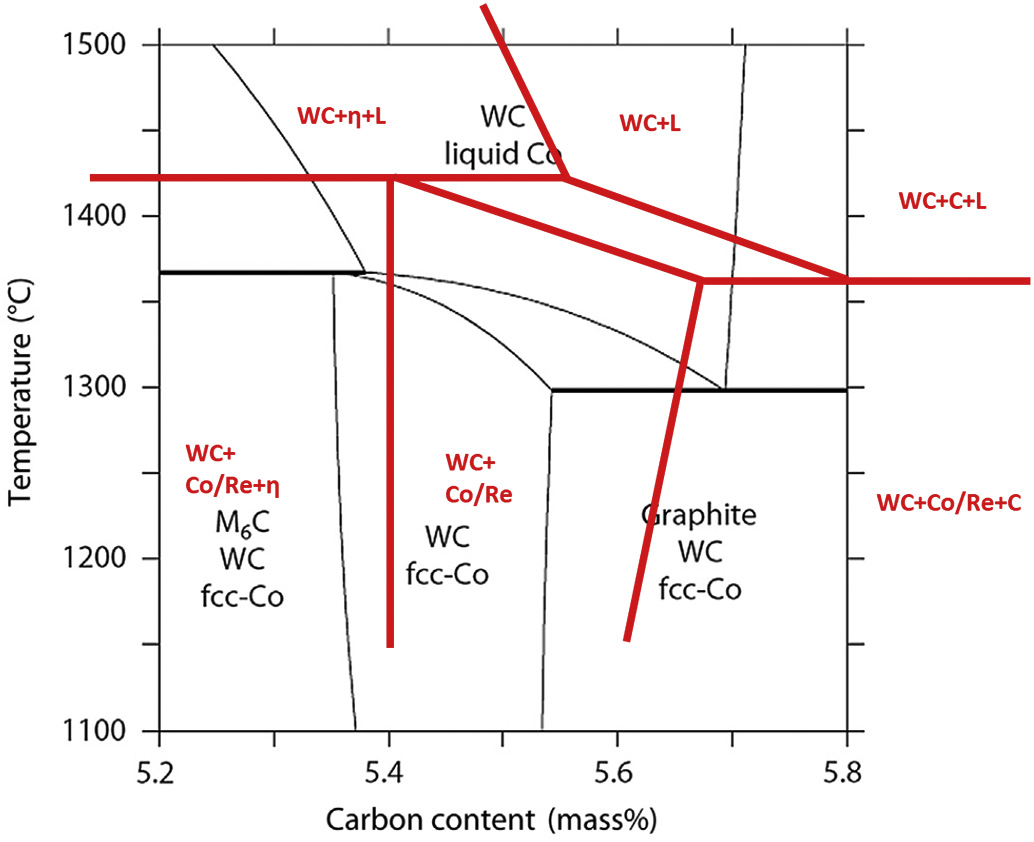
Figure 1 W-Co-Re-C phase diagram of 9 wt% Re + 6 wt% Co (red line) and W-Co-C phase diagram of 10 wt% Co (black line)
Firstly, all the melting points in the W-Co-Re-C phase diagram shift towards higher temperatures. Therefore, compared to traditional WC-Co materials, WC-Co-Re hard alloys require sintering at higher temperatures.
Secondly, for WC-Co-Re hard alloys, the two-phase region without the η phase and free carbon slightly shifts towards the higher end at higher carbon content. This shift is relatively small but still needs to be considered in the preparation of WC-Co-Re hard alloys. It is noteworthy that the width of the two-phase region in the W-Co-Re-C phase diagram is similar to that in the W-Co-C phase diagram.
Finally, the addition of rhenium to the binder significantly expands the region where the equilibrium of WC + η phase + liquid phase exists at temperatures above approximately 1430°C. This means that if WC-Co-Re hard alloys with medium to low carbon and low carbon content are rapidly cooled from the sintering temperature, they may contain the η phase instead of decomposing into thermodynamically stable WC + Co/Re mixtures. Therefore, WC-Co-Re hard alloys after sintering must be cooled at a relatively low cooling rate to ensure the complete decomposition of the η phase.
Figure 2 illustrates this point, showing batches of WC-Co-Re with medium to low carbon content containing η phase after rapid cooling, while not containing η phase after slow cooling.
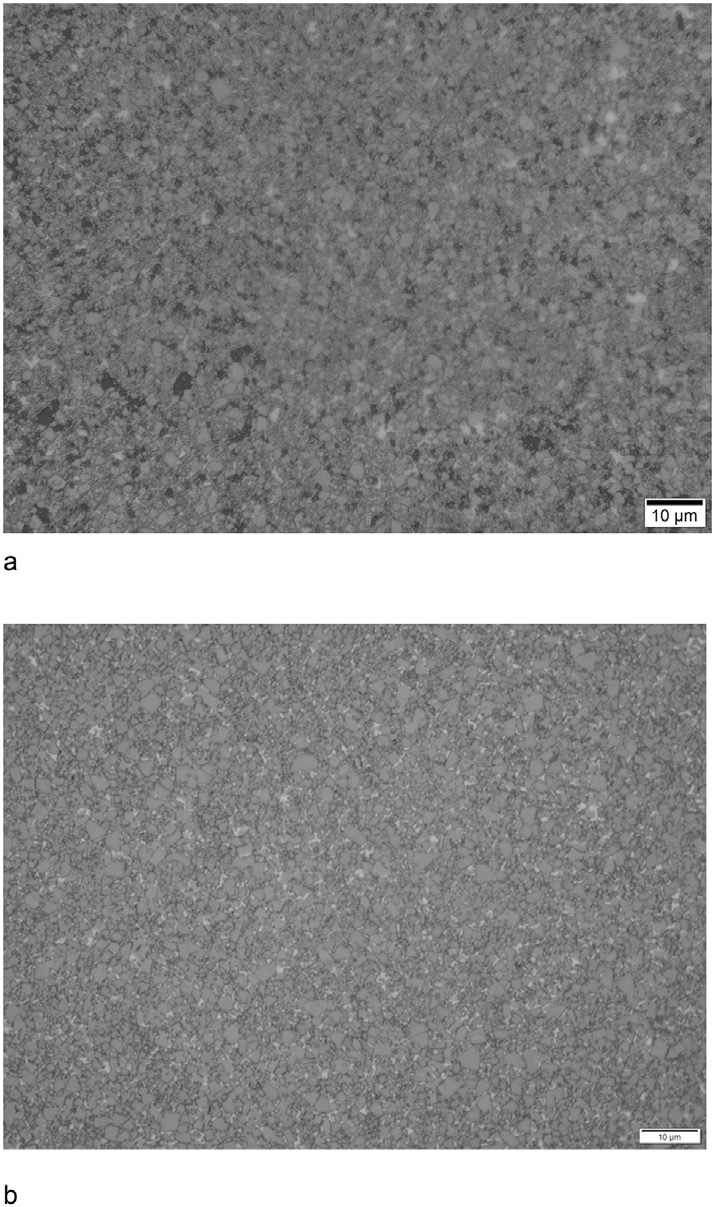
Figure 2 the microstructure of medium-grained WC-Co-Re hard alloys with 9 wt% Re + 6 wt% Co and a total carbon content of 5.45 wt% under different cooling rates from the sintering temperature (1520°C) to 1300°C: (a - cooling rate of 4 degrees/minute, b - cooling rate of 0.5 degrees/minute).
Figures 3 and 4 present the typical microstructures of medium-grained WC-Co-Re hard alloys, compared with traditional WC-Co materials prepared from powder of the same grade. From Figure 3, it can be observed that the microstructure of WC-Co-Re hard alloy is significantly finer than that of traditional WC-Co hard alloy. Therefore, rhenium serves as a strong inhibitor for the growth of WC grains, suppressing the process of WC coarsening. According to the research results, rhenium tends to accumulate at the WC/binder grain boundaries. It can be inferred that the inhibitory effect on the growth of WC grains in WC-Co-Re materials is similar to the inhibitory effect of traditional grain growth inhibitors at the WC-Co grain boundaries.
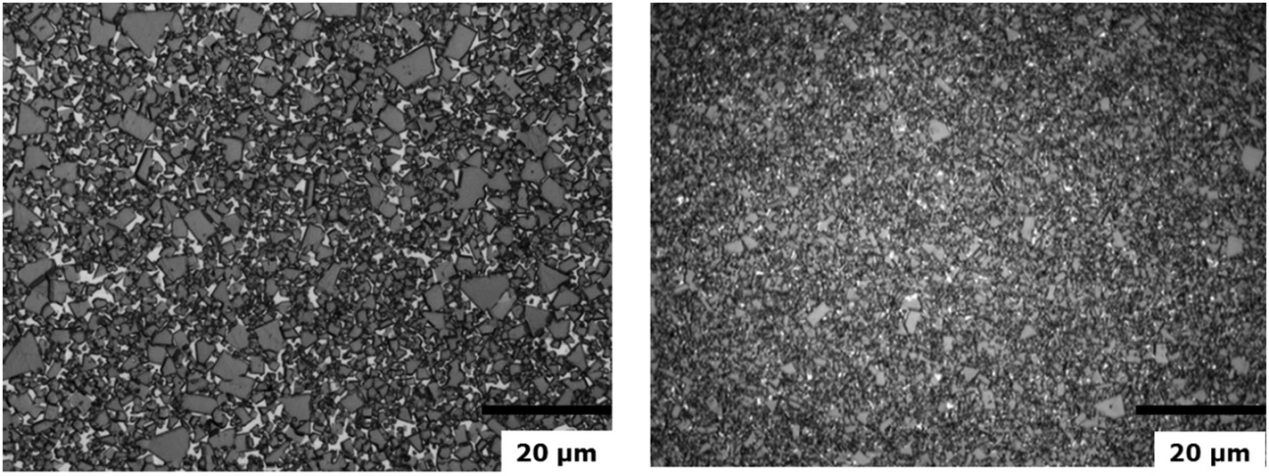
Figure 3 the microstructures of medium-grained WC-10%Co hard alloy (left) and medium-grained WC-Co-Re (containing 9wt% Re + 6wt% Co) hard alloy (right) sintered at 1520°C and then slowly cooled to 1250°C.
Submicron WC-Co-Re hard alloys are commonly used for high-temperature and high-pressure components, and the grain growth inhibition effect of rhenium is crucial for preparing such hard alloys, as traditional grain growth inhibitors are not required to be added to fine-grained WC-Co-Re hard alloys. Figures 4 and 5 show the microstructures of submicron WC-Co-Re hard alloys without grain growth inhibitors. The particles are small and uniform, and there are no unusually large WC particles. The sintering temperature for this hard alloy is 1520°C, significantly higher than the temperature typically used for sintering submicron WC-Co alloys.
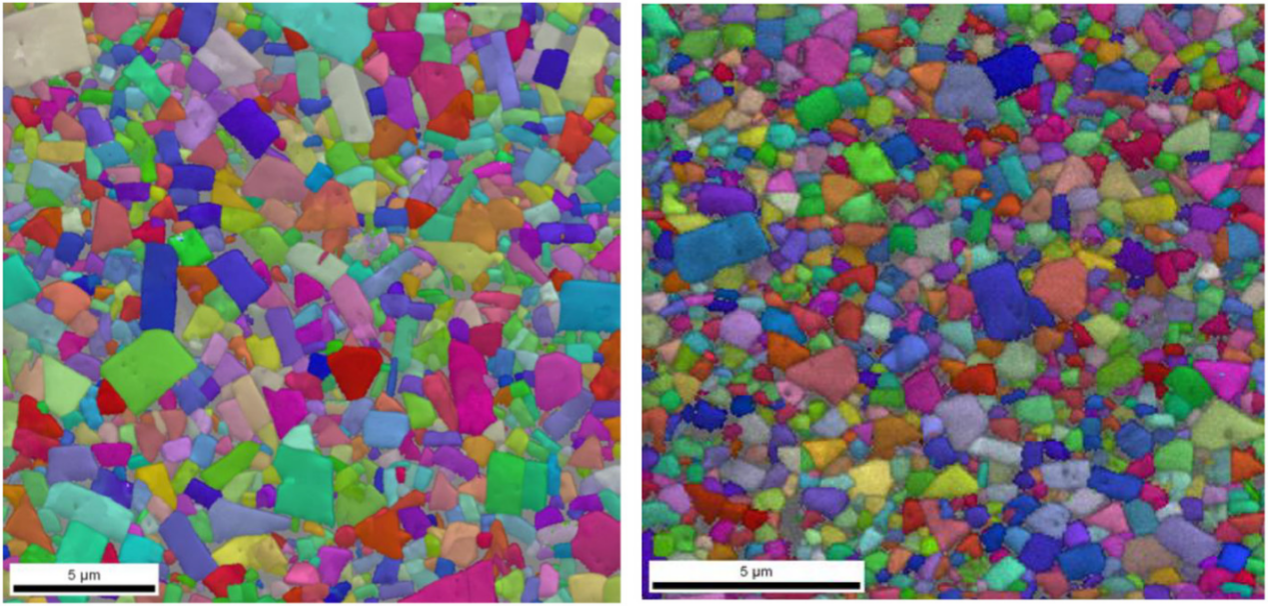
Figure 4 the microstructures of medium-grain WC-Co-Re hard alloy with 9 wt% Re + 6 wt% Co (left) and submicron WC-Co-Re hard alloy with 5.5 wt% Re + 3.7 wt% Co (right).
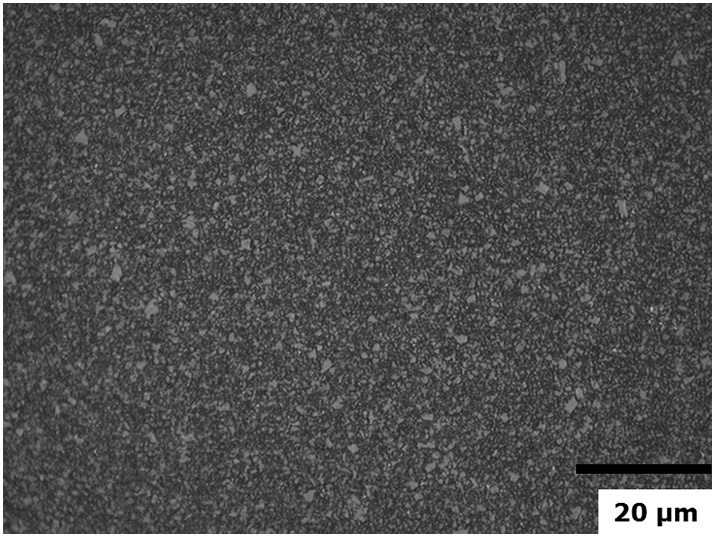
Figure 5 the microstructure of submicron WC-Co-Re hard alloy with 5.5 wt% Re + 3.7 wt% Co.
-
Mechanical Properties of WC-Co-Re Hard Alloys
Research has revealed a significant improvement in the physical and mechanical properties of WC-Co-Re hard alloys at elevated temperatures. The curve in Figure 6 indicates that the hardness of WC-Co-Re material remains more stable with decreasing temperature (20-800°C) compared to traditional WC-Co hard alloys. The temperatures of 300°C and 500°C are commonly encountered in the operation of HPHT components. At these temperatures, WC-Co-Re hard alloys exhibit a hardness reduction nearly twice as low as conventional WC-Co materials. Improved thermal hardness is crucial for the manufacturing of cutting tools used in processing materials such as nickel-based high-temperature alloys, as these tools require high thermal stability and mechanical durability in their cutting edges.
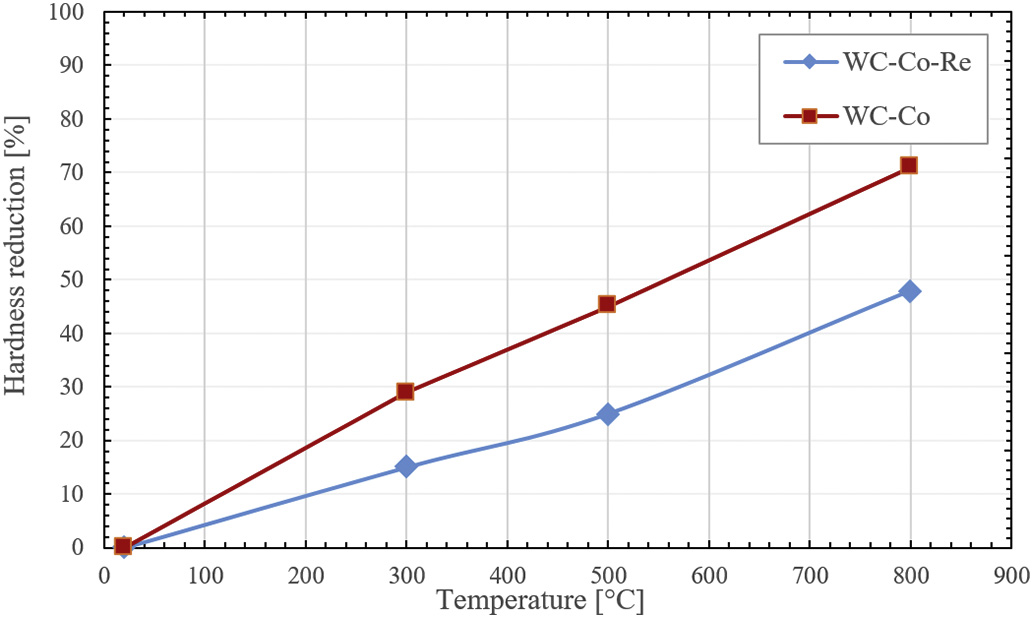
Figure 6 the variation of hardness with temperature when comparing the submicron WC-Co-Re hard alloy containing 5.5 wt% Co + 3.7 wt% Re with the traditional submicron hard alloy containing 6 wt% Co.
Based on the mentioned higher hot hardness of WC-Co-Re hard alloy, it can be inferred that the hard alloy containing Re has improved high-temperature creep resistance. In fact, as shown in Figure 7, the WC-Co-Re hard alloy achieved the same compressive stress rate value at a significantly higher load than conventional WC-Co materials. This indicates that the Co-Re binder has significantly improved high-temperature creep resistance.
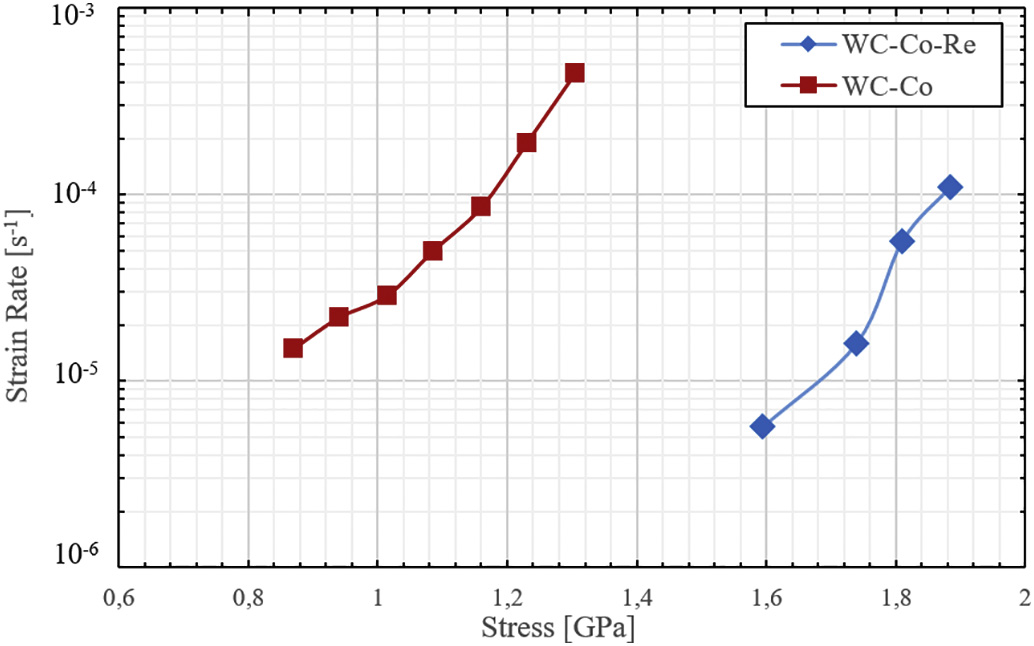
Figure 7 Relationship between strain rate and compressive stress of WC-Co-Re and WC-Co hard alloys at 800°C.
Prospects for the Application of Super Hard Alloy Materials
Despite the high cost of rhenium powder, leading to relatively high production costs for WC-Co-Re hard alloys, they can still find applications in certain fields, especially in areas where high-temperature performance plays a decisive role. Examples include components for high-pressure high-temperature synthesis of diamond and cubic boron nitride, as well as the manufacture of cutting tools for processing high-temperature materials and other heat-generating workpieces.
In high-temperature and high-pressure applications, the increased Young's modulus of WC-CoRe hard alloys should also play a crucial role. It is well known that components operating under high-temperature and high-pressure conditions can be fully recovered after use. WC-Co-Re hard alloys can be recycled and reused similar to conventional WC-Co materials. Therefore, despite the high cost of rhenium, if substantial initial capital is invested, WC-Co-Re hard alloys can be applied in the manufacture of high-temperature and high-pressure components, particularly for the synthesis of diamond and cubic boron nitride.
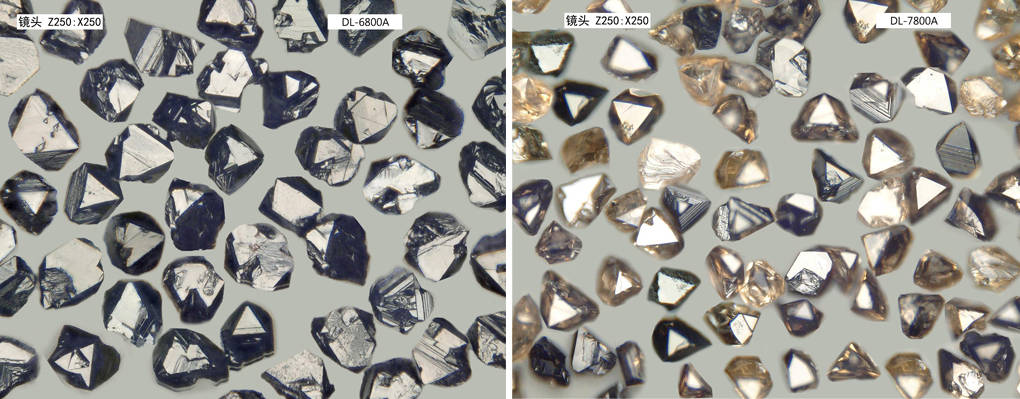
CBN cubic boron nitride single crystal material
Certainly, it is well known that cutting tools used for processing high-temperature alloys and other heat-generating workpiece materials are subjected to extremely high cutting temperatures. Considering the significantly increased high-temperature hardness of WC-Co-Re hard alloys, they can be effectively utilized for machining nickel and cobalt-based high-temperature alloys. Another advantage of WC-Co-Re hard alloys in this application is the ability to produce submicron and ultrafine grades without the need for traditional WC grain growth inhibitors. This is because rhenium possesses a very strong grain growth inhibition effect, ensuring the attainment of cutting inserts with an extremely fine and uniform microstructure.
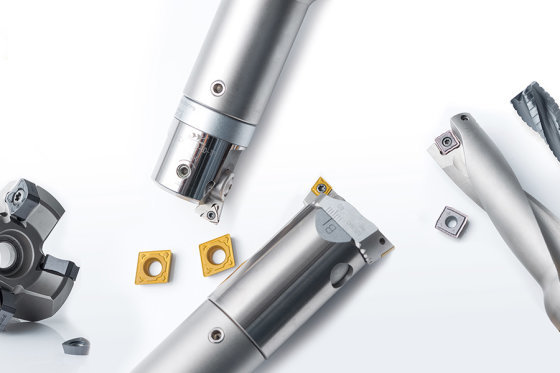
hard alloy cutter
Reference:WC-Co-Re-cemented-carbides-Structure-properties-and-potential
I. Konyashin, S. Farag, B. Ries, B.Roebuck
Scan the QR code to read on your phone
Contact Us
Address: Room 401, Building 10, Xinggong Science and Technology Park, No. 100 Luyun Road, Changsha High-tech Development Zone, Hunan
Email:sales@rheniumet.com

scan it Follow us
Copyright: Hunan Rhenium Alloy Material Co., Ltd. ICP No. 13005464-1 Website construction: www.300.cn


